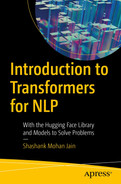Index
A
Application programming interface (API)
Artificial general intelligence (AGI)
Artificial intelligence (AI)
Attention
“Attention Is All You Need”
Attention mechanism
AutoModel
probabilities
text classification
Transformers library
wrapper class
AutoTokenizer
B
Backpropagation (BP)
Bag of words
BERT-Base
BERT-based Q&A
BERT-based tokenizer
BERT-Large
Bidirectional Encoder Representations from Transformers (BERT)
application, bidirectional training
BERT-Base
BERT-Large
huggingface
inference in NSP
input representations
LSTM-type architectures
MLM
performance
pretrained models
sentiment analysis, tweet
training language models process
transfer learning
transformer architecture
use cases
C
Chatbot/dialog bot
CLS and SEP
Code comment generator
CodeGen
CodeT5 model
comment model directory
encoder-decoder transformer model
Google search APIs
Java code
non-huggingface repository
pretrained models
sequential manner
T5 encoder-decoder paradigm
Colossal Cleaned Common Crawl (C4)
Common Crawl
CSV files
D
Decoder
Distilbert-base-cased-distilled-squad
distilgpt2
Docker image
E
Encoder
feed-forward network
input embeddings
layer normalization
multi-headed attention system
residual connections
Exponential function
F
FeatureExtractor
Feed-forward networks
Fine-tuning
datasets
evaluation
Hugging Face
IMDB dataset
inference
neural architecture
Trainer API
training
workflow
Flatter distributions
G
General Language Understanding Evaluation (GLUE)
Google Colab
Google Pegasus model
google/pegasus-xsum model
Google’s BERT
Google’s T5 model
Google Translate
GPT3 model
GPU cluster
Gradio
code generation app
files
Hugging Face
huggingface infra
SDK
summarization app
text generation
translation UI
web framework
H
Harder distribution
Helsinki-NLP/opus-mt-en-de model
Helsinki-NLP/opus-mt-en-fr model
Hugging Face
AutoModel
SeeAutoModel
ecosystem
features
GPT3 model
NLP
open source software and data
pipelines
repository
tokenizer
SeeTokenizer
Transformers library
Huggingface APIs
Huggingface datasets
Huggingface infra
Huggingface spaces
Hugging Face tasks
code comment generator
code generation
dialog system
language translation
Q&A
SQuAD dataset
text generation models
text-to-text generation
SeeT5 model
zero-shot learning
Huggingface UI
Hyperparameters
I, J, K
Image-to-caption mapping
Input document
Input embeddings
L
Language models
advantages
development
neural network–based
word sequences
Large language models (LLMs)
Layer normalization
Long Short-Term Memory (LSTM)
M
Machine learning
Machine translation (MT)
Markov chains
Masked language modeling (MLM)
Masking
Microsoft DialoGPT model
Multi-headed attention system
Multi-headed self-attention (MSA)
Multi-layer perceptron (MLP)
N
Natural language (NL)
generation
understanding
Natural language processing (NLP)
artificial intelligence
history
LLMs
Neural network–based language models
Neural networks
Next Sentence Prediction (NSP)
BERT
inference
n-grams
Num_return_sequences
O
One-hot encoding
OpenAI Codex model
OpenAI’s GPT models
P, Q
Padding
Part-of-speech (POS)
Pegasus system
Pipeline API
Pipelines
Positional embedding
Positional encoding
Pretrained models
fine-tuning
SeeFine-tuning
Hugging Face
huggingface APIs
transfer learning
zero-shot learning
Programming language (PL)
R
Recurrent neural networks (RNNs)
designs
vs. feed-forward networks
GRUs
information
LSTM
in 1980s
sequential data
Residual connection
RoBERTa base model
S
Sampling
Self-assurance
Self-attention
Self-attention mechanism
Sentence paraphrasing task
Sentiment analysis task
Sentiment classification
Sequence-to-sequence (Seq2Seq) neural network
decoder
encoder
encoder-decoder usage
function
LSTM
sequence of objects
Sequential data
Situations with Adversarial Generations (SWAG)
Softer distribution
Span
Stanford Question Answering Dataset (SQuAD)
T, U
T5 language model
T5 model
app.py code
English-to-German
generating questions
Google Research
sentence paraphrasing
sentiment analysis
summarizing text
transformer-based architecture
T5 model–based translation
Temperature
Temperature function
Tensors
Text classification
Text generation
deep learning
GPT2 model
LSTM architectures
Markov chains
parameter num_beams
repetition
RNNs
sampling
straightforward approach
UI
Text mining
Text processing
Text-to-text model
Tokenization
Tokenizer
AutoTokenizer class
BERT-based
code
dictionary
function
Google Colab
GPT2 model
libraries
multiple encodings
padding
pipeline component
specialized tokens
Transformers library
truncation
Traditional NLP models
Trainer class
Transfer learning
Transformer-based models
Transformer-based neural network architecture
Transformers
architecture
decoder
input embeddings and positional encoding
layers
linear classifier and final softmax, output probabilities
multi-headed attention
encoder
component
feed-forward network
input embeddings
layer normalization
multi-headed attention system
residual connections
high-level architecture
library
Seq2Seq models
Transformer-XL
Trigram model
Truncation
V
Vectorization
Vision transformers (ViTs)
architecture
Gradio
image-based machine learning
image classification
MLP
papers
tasks
W, X, Y
Word tokenization
Z
Zero-shot classification
Zero-shot learning
classifier
need for
pretrained model
text classification
UI
..................Content has been hidden....................
You can't read the all page of ebook, please click here login for view all page.
